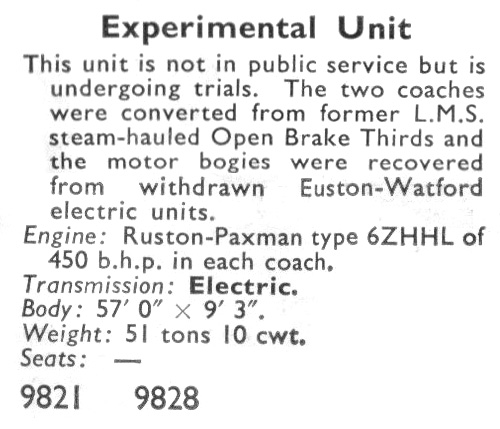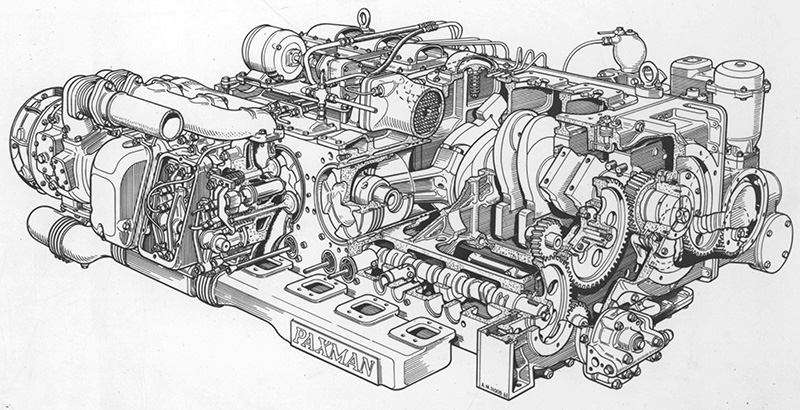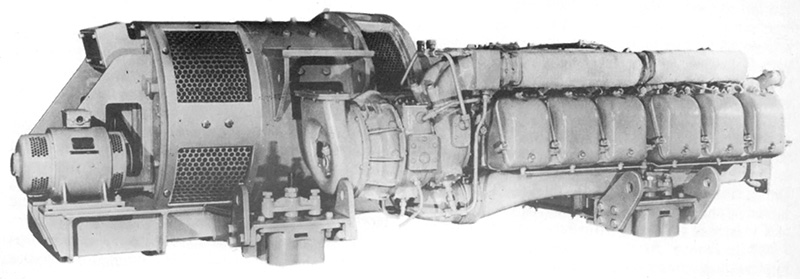Paxman 2-car Diesel-Electric
Description
Bodies
The two bodies were from a batch of all-steel 57ft Period 1 LMS coaches built by Birmingham Railway Carriage & Wagon (Lot 182) in 1926 (1925 on the builders plate). The numbers carried — 9821 and 9828 — were the original vehicle numbers which explains why they were not numerically adjacent.
No passenger accomodation was available on the former open brake thirds, the vehicles were purely a test bed for the Davey-Paxman engines and the interior contained various equipment for the tests. There was no heating fitted.
The driving ends were added to the brake ends on both vehicles with the gangway removed, plated over and three windows added. A marker lamp was added above the centre window (the 114s were being built at the time and they just had this same top lamp arrangement).
The buffer beam on the outer ends was very sparse compared to regular DMUs, no vacumm bags, air pipes or jumper cables, just two buffers and a coupling hook! The vehicles were air braked, but without provision for adding other vehicles.

The vehicles appeared in some early Ian Allan DMU ABCs, as seen in the image. It shows the vehicle weight as 51 tons 10 cwt, more than ten tons heavier than a regular DMU power car.
Engines
Each vehicle had one Paxman 6ZHXL 450hp engine mounted on the underframe. The engine code referred to the following:[1]
6 - six cyliners
Z - in-line, horizontal
H - 7" cylinder bore size
X - turbocharged aspiration with no intercooling
L - for Locomotive/Rail Traction
The ZH series was basically half (one bank) of the YH which was their Vee 12, and was designed specifically with the British Railways railcar market in mind[2]. Although the trials were succesful, British Railways chose not to use them on railcars but the power units would be used in the Clayton Type 1s (Class 17s).
The two engines would be dispatched from the Paxman works in Colchester for their journey to Derby on the 26th and 29th March 1956[3].

The cutaway illustration of the 6ZHXL above is courtesy of and © Paxman Archive Trust.
The image below shows the engine with the BTH (British Thomson-Houston) generator set attached. Note the engine is sitting on two transverse beams with mounting/lifting points, these would sit on a cradle built under the middle of the vehicles.

More details about the ZH engine can be found on Richard Carr's excellent "Paxman History Pages" website. It includes an image of a power unit with an engineer alongside which gives an idea how considerably larger it was than standard railcar engines.
The engine exhaust was through the roof near the middle of the coach[4].
Registers for the company photograph collection (held by the Paxman Archive Trust) show that a cylinder head gasket failure was photographed on 30 November 1956 (Series 2 negatives 6484/5), the only know problem with the engines during the trials. The archives also contain Series 2 negatives 6359-63 taken 14/10/56 at Derby.

Photograph courtesy of and © Paxman Archive Trust - negative 6360.
The engine sitting in the cradle, believed to be on 9821, showing the rear of the engine which is to the left, generator to the right.

Photograph courtesy of and © Paxman Archive Trust - negative 6361.
Engineers examine the engine under one of the vehicles, believed to be 9821.

Photograph courtesy of and © Paxman Archive Trust - negative 6362.
The mid-section of 9828. It had the lifting brackets removed and had two patches on the lower body seen on the right.

Photograph courtesy of and © Paxman Archive Trust - negative 6363.
The mid-section of 9821, note the brackets on the mounting point and no body patches on the right.
In the first two images it can be seen that they were fitted with a Graviner fire extinguishing system using the same type of components as used on regular DMUs: the flame switch under the BRC&W works plate; the fire alarm control panel further to the right; and two fire extinguishers can just be seen, one on either side of the cradle.
Bogies
The bogies were, like the bodies, reclaimed from obsolete stock, in this case Euston-Watford EMUs. It is assumed the existing traction motors were used.
Livery
The vehicles were finished in the DMU style, lined green with speed whiskers. No crests were carried on the sides.
The vehicle numbers lacked a prefix — and a suffix — they had been M9821M and M9828M post-nationisation before the conversion. On the lower cabsides was the text "Not to be traversed".
References
- ⋏ Identifying Paxman Diesel Engine Types - Richard Carr's Paxman History Pages website, accessed 21 April 2021
- ⋏ "ZH Traction Applications - " Paxman and Diesel Rail Traction - Richard Carr's Paxman History Pages website, accessed 21 April 2021
- ⋏ "6ZHXL Engines - " Paxman Rail Traction Diesel Engines - Richard Carr's Paxman History Pages website, accessed 21 April 2021
- ⋏ p328 November 1958 Railway Observer (Railway Correspondence and Travel Society)
Summary
Background
Description
Operations


